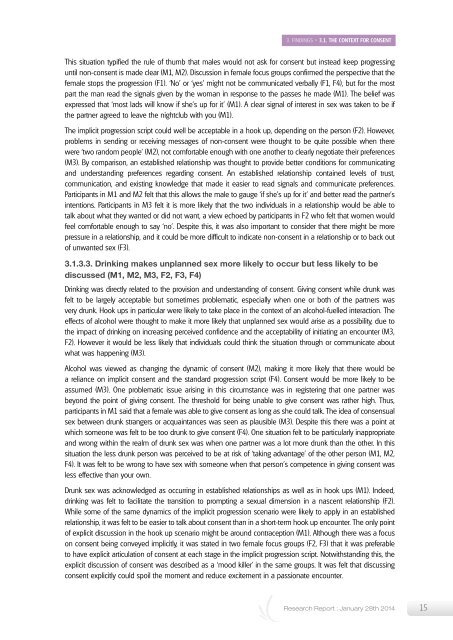Whats-Consent-Full-A41
Whats-Consent-Full-A41
Whats-Consent-Full-A41
You also want an ePaper? Increase the reach of your titles
YUMPU automatically turns print PDFs into web optimized ePapers that Google loves.
3. Findings > 3.1. The Context for <strong>Consent</strong>This situation typified the rule of thumb that males would not ask for consent but instead keep progressinguntil non-consent is made clear (M1, M2). Discussion in female focus groups confirmed the perspective that thefemale stops the progression (F1). ‘No’ or ‘yes’ might not be communicated verbally (F1, F4), but for the mostpart the man read the signals given by the woman in response to the passes he made (M1). The belief wasexpressed that ‘most lads will know if she’s up for it’ (M1). A clear signal of interest in sex was taken to be ifthe partner agreed to leave the nightclub with you (M1).The implicit progression script could well be acceptable in a hook up, depending on the person (F2). However,problems in sending or receiving messages of non-consent were thought to be quite possible when therewere ‘two random people’ (M2), not comfortable enough with one another to clearly negotiate their preferences(M3). By comparison, an established relationship was thought to provide better conditions for communicatingand understanding preferences regarding consent. An established relationship contained levels of trust,communication, and existing knowledge that made it easier to read signals and communicate preferences.Participants in M1 and M2 felt that this allows the male to gauge ‘if she’s up for it’ and better read the partner’sintentions. Participants in M3 felt it is more likely that the two individuals in a relationship would be able totalk about what they wanted or did not want, a view echoed by participants in F2 who felt that women wouldfeel comfortable enough to say ‘no’. Despite this, it was also important to consider that there might be morepressure in a relationship, and it could be more difficult to indicate non-consent in a relationship or to back outof unwanted sex (F3).3.1.3.3. Drinking makes unplanned sex more likely to occur but less likely to bediscussed (M1, M2, M3, F2, F3, F4)Drinking was directly related to the provision and understanding of consent. Giving consent while drunk wasfelt to be largely acceptable but sometimes problematic, especially when one or both of the partners wasvery drunk. Hook ups in particular were likely to take place in the context of an alcohol-fuelled interaction. Theeffects of alcohol were thought to make it more likely that unplanned sex would arise as a possibility, due tothe impact of drinking on increasing perceived confidence and the acceptability of initiating an encounter (M3,F2). However it would be less likely that individuals could think the situation through or communicate aboutwhat was happening (M3).Alcohol was viewed as changing the dynamic of consent (M2), making it more likely that there would bea reliance on implicit consent and the standard progression script (F4). <strong>Consent</strong> would be more likely to beassumed (M3). One problematic issue arising in this circumstance was in registering that one partner wasbeyond the point of giving consent. The threshold for being unable to give consent was rather high. Thus,participants in M1 said that a female was able to give consent as long as she could talk. The idea of consensualsex between drunk strangers or acquaintances was seen as plausible (M3). Despite this there was a point atwhich someone was felt to be too drunk to give consent (F4). One situation felt to be particularly inappropriateand wrong within the realm of drunk sex was when one partner was a lot more drunk than the other. In thissituation the less drunk person was perceived to be at risk of ‘taking advantage’ of the other person (M1, M2,F4). It was felt to be wrong to have sex with someone when that person’s competence in giving consent wasless effective than your own.Drunk sex was acknowledged as occurring in established relationships as well as in hook ups (M1). Indeed,drinking was felt to facilitate the transition to prompting a sexual dimension in a nascent relationship (F2).While some of the same dynamics of the implicit progression scenario were likely to apply in an establishedrelationship, it was felt to be easier to talk about consent than in a short-term hook up encounter. The only pointof explicit discussion in the hook up scenario might be around contraception (M1). Although there was a focuson consent being conveyed implicitly, it was stated in two female focus groups (F2, F3) that it was preferableto have explicit articulation of consent at each stage in the implicit progression script. Notwithstanding this, theexplicit discussion of consent was described as a ‘mood killer’ in the same groups. It was felt that discussingconsent explicitly could spoil the moment and reduce excitement in a passionate encounter.Research Report : January 28th 201415


